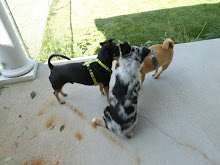I bought a couple of different patterns from the one I'd been using to make my totes, in part because the tissue paper was poked to death by needles and getting fragile, and in part because I wanted to learn new ways of making bags. This latest purse was made from the Simplicity 8310 pattern.
One pocket on the outside front.
Two pockets on the outside back.
Three pockets on the inside.
I reversed the fabrics for the inside and outside back pockets to avoid overpowering the purse with green.
As usual, there were a few snags along the way. I have trouble comprehending pattern directions, so I spend a lot of time reading and re-reading, staring at the diagrams, trying different things, and ripping out seams. What works best for me is sleeping on it, because I usually wake up in the morning with a clear picture in my head on how I am supposed to assemble it.
For instance, the interior pockets were one long strip. I noticed that the diagram suddenly showed the one long strip divided into three pockets, but nowhere were there instructions on sewing that pocket. I thought it was an oversight, until I sewed the front pocket on, and realized that I had sewed right through to the interior strip, instantly dividing it into three pockets. It's a genius way to save thread, avoid having to measure and draw chalk lines, and consolidate what would have been multiple steps into one.
Perhaps I had the biggest trouble with the bottom corners. The instructions said to sew darts between the outside dots, and there were many ways to interpret that. I kept folding and refolding the corners, yet nothing made sense until I slept on it. This time I made notes along the way, so hopefully I won't make the same mistakes in the future. The end result was all done correctly. There was nothing that I did wrong that I couldn't undo.
There are a lot more fine details to this bag, such as the bias tape used to hide seams and allow for a decorative touch.















